-
292021. 03
No. 188 View. 444167

KISTI published a book entitled “A Study on the 3D Printing Industry Revitalizat...
KISTI published a book entitled “A Study on the 3D Printing Industry Revitalization Plan,” covering 3D printing technology and material information by experts in machinery, metals, polymers, and ceramics. KISTI said, "In the situation that 3D printing is popular domestically and internationally, but related specialized books are insufficient, the principles of 3D printing, materials, software, application fields, etc. are systematically organized for each technology and material to provide a clear view of the latest trends.“ Along with the 4th Industrial Revolution, 3D printing, which is called the digital revolution of manufacturing systems, is attracting attention because it is highly likely to bring about a transformation of the traditional business model along with the existing manufacturing method innovation. The global market for 3D printing is expected to reach 26.2 billion dollars (about 29 trillion won) in 2022. Currently, in the global 3D printing industry, a number of overseas companies such as the United States, Japan, China, and Europe are leading the business based on their technology, and they are taking the lead in product commercialization by applying 3D printing to the manufacturing process. In the case of the domestic market, it has been used for manufacturing prototypes in the fields of education, aerospace, and automobile parts manufacturing over the past several years, and is being used in the production of ed products, mainly in medical, dental, and consumer goods. The market growth rate has been somewhat sluggish so far, but the government is actively discovering successful cases to raise the market size to 1 trillion won by 2022. -
242021. 03
No. 187 View. 456231
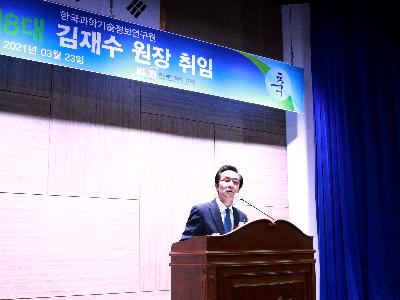
Dr.Kim Jaesoo inaugurated as the 8th president of KISTI
Dr. Kim Jaesoo inaugurated as the 8th president of KISTI . He expressed his aspiration at the inauguration ceremony held at the KISTI auditorium on Mar.23rd. He presented TRUST(Timely, Reliable, S&T innovation, Transparent) as his 5 managing strategies and mentioned KISTI will focus on establishing a digital-based national open science system supporting national R&D innovation. He also said that “even though the transition to data-driven research called 4th generation R&D ed for several years, it was difficult for researchers to get out of the existing R&D framework due to the slow progress of data open and fusion., we will solve it ”. “to this end, KISTI will integrate and open its S&T information, national R&D and research data and will build S&T Data Dam for AI learning so that domestic science and technology R&D can be transformed into a data-oriented system” he emphasized. Dr.Kim Jaesoo obtained a Ph.D. in Electronic Computer Engineering from Hongik University in 2009 and served as the Director of National Science and Technology Data Division, the Director of Convergence Technology Research Division. -
052021. 03
No. 186 View. 450888
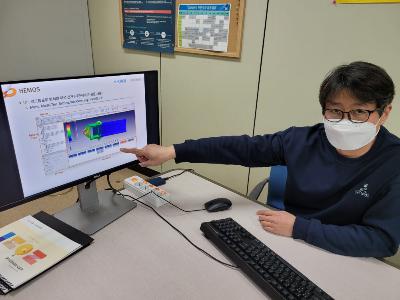
KISTI, Developing Fluid Dynamic Simulation SW for SMEs
KISTI has developed an open source based tool that can be used for fluid dynamics simulation. It is expected to be of great help to SMEs that cannot purchase expensive related software. KISTI M&S Center announced on Mar.1st that it developed “HEMOS Fluid” for this purpose and received GS(Good Software) certificate. HEMOS is an open source based solver(structural analysis software) and a library (a post-processing tool used for structural analysis). It is a entry level CAE (Computer Aided Engineering) software. HEMOS Fluid visualizes simulation and prediction performance results by entering multiple variables. KISTI researchers made it intuitive and easy compared to existing fluid mechanics software. The workflow method is applied to the user interface (UI) so that domestic SMEs can use it a lot, displaying the current work stage and all stages, and diagramming them. HEMOS Fluid can analyze basic steady-state heat flow. Currently, the focus is on versatility and plans to expand its functions every year. It is also a feature that has already received GS certificate. GS certificate is a national certification given to software that has passed the quality test based on ISO international standards. GS ensures objective quality, safety and reliability. This service is being served free of charge on HEMOS Cloud operated by KISTI. HEMOS Cloud is also linked with KISTI supercomputer Nurion. When complex analysis is required, Cloud and Nurion can be used at the same time. In addition to HEMOS Fluid, KISTI also operate HEMOS Structure for structural mechanics, and Hemos HVAC for indoor aerodynamics. In the case of HVAC, visualization tools using virtual reality and augmented reality are also prepared. They have received GS certificate too. “We plan to add functions such as movable material analysis and rotor analysis to HEMOS Fluid,” and “ It is expected to attract more use of SMEs experiencing SW purchasing problems.” said Kim Myung-il, Director of M&S Center. -
022021. 03
No. 185 View. 431149
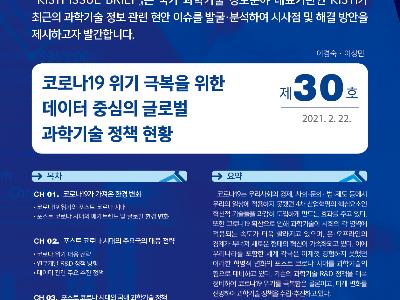
S&T Policy and R&D Innovation to overcome COVID-19
KISTI has introduced the science and technology policy directions and R&D innovation contents in major countries in the world to overcome the Corona 19 crisis in its Issue Brief Vol.30. It also provides knowledge, implications, and countermeasures based on information data-based analysis techniques related to recent national social issues. According to the Issue Brief, the PostCorona society is expected to be recorded as a digitization momentum in the social and economic structure due to the increase in non-face-to-face life patterns, decline in collectivism, and the normalization of telecommuting and distance education. It is expected that non-face-to-face services will become common, the biohealth market and concept will be expanded, and the role of government will be strengthened according to routine risk management in everyday life. Accordingly, the United States is enacting the Coronavirus Support Relief Economic Stability Act, implementing large-scale financial support, and investing large-scale financing in the R&D field of infectious disease. Germany is promoting digital transformation in existing industries through key industrial investments, and expanding the budget for R&D (vaccines, drug development, etc.) related to Corona 19. Japan has set an innovation strategy direction that focuses on remedying the damages of the manufacturing industry from Corona 19 and digital transformation in the future. In addition to its R&D strategy, China is promoting a wide range of measures such as production, high-tech, SME support, manpower policy, and science and technology governance. Major foreign countries' science and technology R&D policy directions are emerging as large-scale investment expansion to cope with the global value chain change and trade blockage caused by Corona 19. The role and policy direction of domestic science and technology in the new normal era were also presented. He said that it is necessary to provide objective data based on scientific facts on the social change of the corona crisis, research infectious diseases and provide scientific and technological answers for responding to the new normal era, and prepare for a preemptive future based on science and technology. It has been revealed that the R&D model innovation and the digital transformation of the industry can turn crisis into an opportunity, and advance to a better future through online education, reinforcement of crisis response research, and data-based policies. KISTI also explained that it intends to respond to the new normal era by providing a national supercomputing infrastructure, building a science and technology data dam, data-based research, and providing an R&D innovation platform. Cho Kumwon, Acting President of KISTI said, “In order to reflect on the changing aspects of our society and the importance of science and technology roles in the process, and to preemptively prepare for the coming future, KISTI will put more efforts into R&D innovation with government research institutes(GRIs) -
042021. 02
No. 184 View. 411163
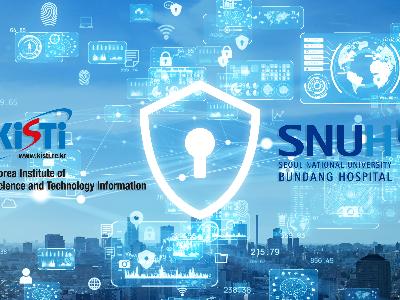
KISTI with SNUBH(Seoul National University Bundang Hospital), is speeding up its...
After concluding MoU last year, KISTI and SNUBH are conducting joint research to establish a system for the practical use of bilateral cryptographic communication and homomorphic cryptography technology. Until now, KISTI has provided quantum cryptographic communication channels and supercomputing infrastructure using the national science and technology research network, and SNUBH has been striving to develop homomorphic cryptographic technology for remote operation based on medical big data. With the joint research on track, KISTI plans to provide a safer big data research environment by constructing a quantum cryptographic communication section for remote transmission and processing of sensitive data based on the National Science and Technology Research Network. SNUBH has already completed the selection of medical research scenarios and functional tests of the isomorphic cryptography library to establish a system for commercialization of homomorphic encryption technology. Dr.Oh Chang-wan, Director of the Life Research Institute of SNUBH said that the commercialization of homomorphic encryption technology will provide an opportunity for medical artificial intelligence technological innovation. Dr. Wonhyuk Lee of Science and Technology Research Network Center of KISTI said that KISTI's high-speed computing technology and infrastructure such as network capabilities will be used to solve the problem of noise processing amplified in the homomorphic encryption process. -
032021. 02
No. 183 View. 382580
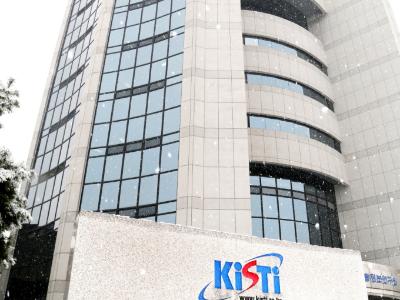
An expert research society was established to study quantum computer security
An expert research society was established to study quantum computer security that can easily penetrate cryptographic systems used in e-commerce, etc. KISTI announced on Feb. 01 that it will establish a “quantum security research group” in the Korea Institute of Information Security and Cryptology and take the role of a secretary to research quantum and security technologies. Public-key cryptographic algorithms used for authentication and digital signatures in electronic financial transactions utilize prime factorization and discrete logarithm problems. The password needs solution to be solved and is highly safe cause it will take decades or more even with supercomputers around the world. However, a quantum computer that uses a quantum mechanical state in which 0 and 1 exist at the same time, rather than the binary systemof 0 and 1, can quickly solve the problem, raising security concerns. On the 15th of last month, the Korea Institute of Information Security and Cryptology established a quantum security research group for academic development between quantum and security technologies. The goal is to study quantum computer security technologies such as quantum distribution keys and quantum resistant encryption, and to present technical standards and directions. Participants of the research group decided to share related technologies and contribute to information exchange between industry-academia and research institutes by holding bilateral and security technology seminars and training. Jae-cheol Ryu, President of the Korea Institute of Information Security and Cryptology(Professor of Computer Convergence, Chungnam National University) said, "Quantum and security technology area future technology that members of the society are very interested in and and we will also continue to provide support for the development of the quantum cryptography research conference.” Seok Woo-jin, Director of the KISTI Science and Technology Research Network Center, who served as a secretary of the Quantum Security Research Group, said, "Through this research group, we will continue to strive to cooperate with participants and create research results so that quantum security technology can be incorporated into KISTI's national science and technology research network." . -
262021. 01
No. 182 View. 345942
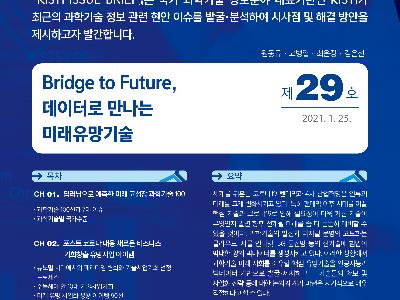
KISTI introduced “Future Promising Technology Seminar 2020” in its Issue Brief N...
KISTI introduced “Future Promising Technology Seminar 2020” in its Issue Brief No. 29, which discovered and presented the core promising technologies that will influence the future society of science and technology after the Corona 19 pandemic. KISTI selected the top 100 future high-growth science and technology areas (clusters) using the optimal deep learning prediction model. About 20 million scientific and technological papers published around the world over the past 14 years were analyzed and issue key words for each top 100 science and technology areas were identified after 7 years. 7 issues were derived according to the distribution of concurrent occurrences of each issue keyword. It also introduced 10 technology commercialization opportunities that should be noted. 1. Contact tracking system 2. Augmented Reality(AR), 3. Digital health 4. Service robot 5. Biosecurity 6. Unmanned vehicle 7. On-site diagnosis device 8. Electronic conference system 9. Cloud data storage device 10. Digital education Platform, etc. The government's R&D investment fields and strategies in the post-corona era were also presented. As promising investment technologies in the digital new deal field, future eco-friendly vehicles, autonomous vehicles, high-performance unmanned vehicles, artificial intelligence (AI), system semiconductors, precision medicine, smart farms, intelligent robots, and smart cities were selected. For the green new deal are fine dust, smart grid, solar power, fuel cells, wind power, and biomass. Dr. Kum Won Cho, Acting President of KISTI, said "I look forward to the efficient use of future promising technologies that will become catalysts for technological innovation and new business creation after the Corona 19 pandemic." -
252021. 01
No. 181 View. 304141
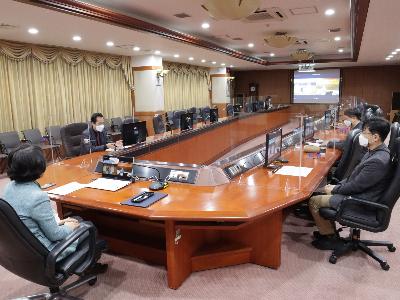
KISTI has concluded MoU with DataStreams to revitalize the data
KISTI has concluded MoU with DataStreams to revitalize the data KISTI has concluded MoU with DataStreams to revitalize the data-driven research ecosystem. With this MoU, KISTI plans to establish a data-based research cooperation system by linking its science and technology information with Datastreams' big data platform 'Teraone.' In addition, KISTI plans to develop intelligent services to strengthen the D, N, A (data, network, artificial intelligence) ecosystem, and promote mutual cooperation to apply new technologies in the domestic and overseas data management fields. Dr. Choi Hee-yoon, President of KISTI, said “With this MoU, we expect to present customized solutions for science and technology data and improve the utilization of national R&D achievements,” and “In particular, it will raise a new perspective on establishing a national R&D environment.” -
262020. 11
No. 180 View. 153992 Emerging Tech Seminar 2020 KISTI has held Emerging Tech Seminar 2020 on 'Bridge to Future, Emerging Technologies through Data,' on November 26th, 2020, through the online platforms. The seminar this year focuses on searching new commercialization and creating companies' value of Small and Middle size Enterprises in the era of post-corona by providing leading emerging technologies and business items through information analysis on science and technology. In addition, it consists of the presentations based on the intelligent analysis on information and data: 100 rapidly developing future technologies predicted by deep-learning technology; the government's investment fields and strategies on R&D in the post-corona era; and new commercialization items that can help SMEs have more business opportunities. At the end of the seminar, a panel discussion on future innovation strategies with data in the Digital New Deal era has been followed, which is expected to advance opinions about what future innovation data that create new business and extract enterprises' innovation are, and how they can achieve their future innovation through information analysis.
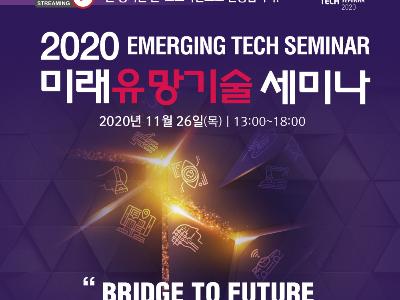
-
192020. 10
No. 179 View. 181977
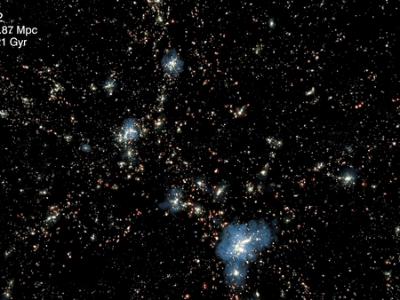
World Biggest Cosmological Fluid Mechanics Simulation
World Biggest Cosmological Fluid Mechanics Simulation KISTI with KIAS, Korea Institute for Advanced Study, and KASI, Korea Astronomy & Space Science Institute, jointly conducted the world biggest numerical simulation, Horizon Run 5, which calculates both calculation of cosmos and creation of galaxies. KISTI allocated 2,500 calculation nodes of NURION, its 5th supercomputer, which corresponds 7.5 petaflops, and ran the simulation for 3 months. The research team selected French fluid mechanics numerical simulation code RAMSES, and they also optimally parallelized it for the maximum efficiency. Newly developed RAMSES makes it possible to calculate gaseous heat and loss by supernova and active galactic nucleus; evolution of contents of heavy elements such as oxygen and iron; and detailed physical evolution process of supermassive black holes. Limitation of spatial size of virtual universe of the previously conducted world biggest cosmological fluid mechanics simulations has made it difficult to find out the correlation between growth of large spatial structures and evolution of galaxies. HR5 is a simulation with expanded scale, so it can realistically reproduce creation and evolution of galaxies based on the standard cosmological model.

 Delete Article!
Delete Article!